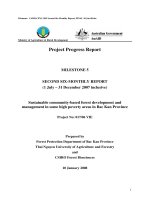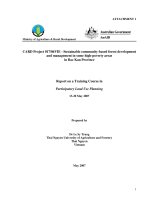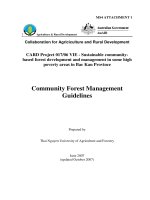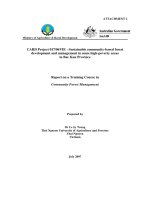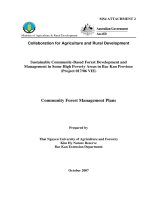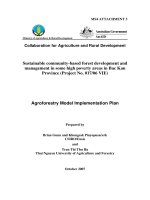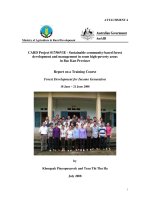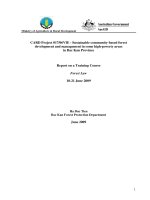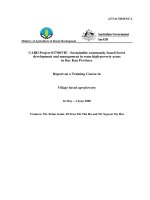Application of water quality index (WQI) in assessing surface water quality in bac kan province, vietnam
Bạn đang xem bản rút gọn của tài liệu. Xem và tải ngay bản đầy đủ của tài liệu tại đây (1.04 MB, 56 trang )
THAI NGUYEN UNIVERSITY
UNIVERSITY OF AGRICULTURAL AND FORESTRY
DANG CHAU GIANG
APPLICATION OF WATER QUALITY INDEX (WQI) IN ASSESSING
SURFACE WATER QUALITY IN BACKAN PROVINCE VIETNAM
BACHELOR THESIS
Study Mode : Full-time
Major
: Environmental Science and Management
Faculty
: Advanced Education Program
Batch
: 2014 - 2018
Thai Nguyen, 25/9/2018
DOCUMENTATION PAGE WITH ABSTRACT
Degree program
Bachelor of Environmental Science and Management
Full name
DANG CHAU GIANG
Student ID
DTN1453120001
Thesis title
Application of water quality index (WQI) in assessing surface
water quality in Bac Kan province, Vietnam
Supervisor
MSc. Nguyen Van Hieu
Supervisor
signature
Abstract:
Vietnam has a relatively dense network of rivers, but the rapid socio-economic
development has led to many heavily polluted river basins. Therefore, environmental
protection in river basin has been attracted much attention in term of their urgent
status. This thesis used the Water Quality Index (WQI) to evaluate the surface water
quality of large rivers and lakes in Bac Kan province which situated in the Northern
part, Viet Nam in April and June, 2017 then compare the result of these two phase
together to propose the solutions for integrated management of surface water
resources of Bac Kan province toward sustainable development. For calculating
WQI, 10 parameters namely PH, BOD5 (Biological Oxygen Demand), COD
(Chemical Oxygen Demand), DO (Dissolved Oxygen), TSS (Total Suspended
Solids), Coliform, Ammonium-nitrogen (N-NH4+), Phosphorus (P-PO43-), Turbidity
and Temperature (T℃) were considered. It is apparent from WQI values that the
overall surce water quality is relatively good, surface water quality in Bac Kan
province in the second phase lower than that in the first phase. The reason was that, in
June 2017, rain occurred with high intensity, which eroded river bank, leading the
soil was washed away into rivers and streams, making the content of TSS in surface
water increased.
Keywords
Water pollution, Water Quality Index (WQI)
Number of pages
47
Date of submission
25/9/2018
i
ACKNOWLEDGEMENT
Foremost, I would like to express my sincere gratitude to my advisors Msc.
Nguyen Van Hieu for their infinite guidance, patience, generous encouragement and
supports to me to finish my work step by step. I appreciated all the apportunities my
advisor offered me by giving me intellectual freedom in my work, engaging me in new
ideas, and demanding a high quality of work in all my endeavors.
Besides my advisors, I would like to thank to Center for Space and Remote
Sensing Research (CSRSR) and Geo-Informatics Research Center (GIRC) of Thai
Nguyen University of Agriculture and Forestry (TUAF) for providing me all the
necessary facilities and scientific knowledge to complete this thesis and my deep
gratitude also goes to Thai Nguyen University of Agriculture and Forestry which helps
me gain to deep knowledge about Environmental science and Management
I would be remiss if I did not thank to fellow labmates in CSRSR and GIRC for
their kindness and help in training me and for many valuable advices that given to me
whenever I get stuck with my research.
Last but not the least, I would like to thank my family for their unconditional
love and support they gave me throughtout the research process.
Thai Nguyen, 25/09/2018
Student
Dang Chau Giang
ii
TABLE OF CONTENTS
LIST OF FIGURES ......................................................................................................iv
LIST OF TABLE ...........................................................................................................v
LIST OF ABBREVIATION ........................................................................................vi
PART I. INTRODUCTION ..........................................................................................1
1.1. Research rationale ....................................................................................................1
1.2. Research objectives ..................................................................................................2
1.3 Significance of study .................................................................................................3
1.4 Limitation of study ....................................................................................................3
PART II. LITERATURE REVIEW ............................................................................4
2.1. Study area and water quality in the study area .........................................................4
2.1.1. Study area ..............................................................................................................4
2.1.2 Water quality in the study area ...............................................................................5
2.2. Overview of WQI .....................................................................................................6
2.3. WQI construction method ........................................................................................6
2.3.1. Method to build WQI of some countries in the world ..........................................6
2.3.2. Method to build WQI in Vietnam .........................................................................7
PART III. METHODS ................................................................................................10
3.1 Stages of research ....................................................................................................10
3.2. Statistical methods and aggregation of secondary data. .........................................10
3.3 WQI calculation method..........................................................................................18
PART IV. RESULTS AND DISCUSSION ...............................................................22
4.1 Ban Kan hydrographic features ...............................................................................22
4.2. Evaluation of surface water quality in Bac Kan province ......................................22
PART V. CONCLUSION ...........................................................................................32
5.1. Conclusion ..............................................................................................................44
5.2. Recommendation ....................................................................................................45
REFERENCE...............................................................................................................47
iii
LIST OF FIGURES
Figure 1. Map of Study area (Source: Google Earth pro) ...............................................5
Figure 2. Chart of BOD5 concentration in surface water stage 1 in 2017 ....................25
Figure 3. Chart of COD levels in surface water stage 1 in 2017 ...................................26
Figure 4. Chart of TSS concentration in surface water stage 1 in 2017 ........................26
Figure 5. Chart of BOD5 concentration in surface water phase 1 compared with phase
2 in 2017 ........................................................................................................................36
Figure 6. Chart of COD concentration in surface water phase 1 compared to phase 2
in 2017 ...........................................................................................................................36
Figure 7. Chart of TSS levels in surface water phase 1 compared to phase 2 in 2017 .37
iv
LIST OF TABLES
Table 1. List of monitoring stations ..............................................................................11
Table 2. Table regulated for qi, BPi values ...................................................................19
Table 3. Regulated BPi, qi values for DO% saturation .................................................20
Table 4. Table regulated BPi and qi values for pHtime ................................................20
Table 5. Water Quality Index (WQI) at Surface Water Surface Monitoring in Bac Kan
province, phase 1 in 2017 ..............................................................................................27
Table 6. Water Quality Index (WQI) at surface water surface monitoring in Bac Kan
province, phase 2 in 2017 ..............................................................................................38
v
LIST OF ABBREVIATIONS
BTNMT:
Ministry of natural resources and
environment
BOD:
Biological Oxygen Demand
BVMT:
Environmental protection.
COD:
Chemical Oxygen Demand
CP:
Government.
DO
Dissolved Oxygen
LVS:
River Basin
ND
Decree.
QA:
Quality assurance.
QC:
Quality control
QCCP:
Permissible standards
QCVN:
Vietnamese Standards.
QD:
Resolution.
TCVN:
Vietnam standard.
TSS
Total Suspended Solids
TT:
Town
TTg:
Prime Minister
TTQTMT:
Environmental Monitoring Center
TW:
Central government
UBND:
People's Committee
WQI:
Water Quality Index
vi
PART I. INTRODUCTION
1.1. Research rationale
Currently, along with the development of the country towards Industrialization Modernization takes place strongly, the environment in general and the water
environment in particular is greatly affected. Spontaneous, unplanned activities such as
uncontrolled logging, inadequate agricultural practices, and direct discharge into water
bodies have resulted in polluted water, clean water shortages is becoming more serious
than ever before in less rainy areas.
The water is used in the dry season with big quantity, especially the amount of
water used for agriculture. The total volume of water needed during the dry season in
2000 was 70.7 km3, accounting for 42.4% of total water that can be supply for the dry
season (including river water, spring water, groundwater and water from the reservoirs).
Moreover, in many areas and river basins, the amount of water needed can be several
times the amount of water that can be supplied Vietnam is a developing country.
Although, receiving much attention from the government, still only 46-50% of urban
population and 36-43% of rural population have access to clean water. Many people in
different regions also have to use water sources that do not meet hygiene standards,
resulting in a high proportion of the population is infected: 90% of rural women suffer
from gynecological diseases, 95% of children infected with germs, worms etc. Water
pollution is the cause of the potential risk of diseases in the locality (VNCOLD 2014)
Bac Kan is a mountainous province in the Northern part of Vietnam with mountain
ranges in the Gam River arch and Ngan Son arc, so it is also home for dense network of
rivers and streams flowing in many directions around. Bac Kan has 7 main rivers with a
total length of 343 km, basin area of 3,935 km2, total water reserve of the river about
1
3,513 million m3, including 7 rivers: Cau river, Yen river, Phat Dat river, Bac Giang
River, Na Ri River, Hien River and Bang Khau River. Bac Kan has more than 40 lead,
zinc, gold and stone mining sites. Due to poor management, most mines have no
wastewater treatment system, so waste water in and after extraction are discharged
directly into rivers and streams, causing the water in the mining areas seriously polluted (
In order to overcome the above difficulties, one or more indicator systems should
be used to allow an integrated view of water quality in terms of physical and chemical
indicators of water resources, evaluated on a uniform scale, understandable with common
objects. One of the indicator systems is the "Water Quality Index (WQI), which has the
advantage of being simple, easy to understand, generalizable and can be used for the
purpose of assessing the quality of water in space and time. Beside of that, WQI is a good
source of information for the community, for non-water professionals who were not in
the field of water environment. For the reasons mentioned above, I selected the topic
"Application of WQI in assessing surface water quality in Bac Kan province, Vietnam”
1.2. Research objectives
- Learn about the WQI and hydrographic features in Bac Kan province
- Collection of documentary information: inherit the results available, collected,
analyzed through reports, research topics, and reports on environmental impact
assessment.
- Processing of raw data and through the WQI calculation and assessment of water
quality for each river and stream in the Bac Kan city
2
1.3 Significance of study
Study based on WQI parameters and WQI calculations on all observations in the
province to assess the surface water quality in large rivers and lakes and to propose
appropriate management measures
1.4 Limitation of study
In this study, new monitoring and WQI values were obtained for the second round
of 2017, which only compared the changes in environmental quality during the year,
which could be compared with previous years to assess the changing water environment
between years.
3
PART II. LITERATURE REVIEW
2.1. Study area and water quality in the study area
2.1.1. Study area
Bac Kan a province of Vietnam. It is located in the Northeast region, due north of
the capital Hanoi geography between 22.3033° N and 105.8760° E. The province covers
an area of 4,859.4 square kilometers and as of 2008 it had a population of 308,900
people. It is a mountainous terrain with rich natural resources of minerals and forests. It has
numerous mountains, rivers and lakes which are very scenic.
The province is in the northeast midland mountainous area of Vietnam. Its terrain
has the highest altitude among the 11 provinces of the region. Forest area dominates
more than 95% of the province. The remainder is available for agricultural and other
uses. Due to this rugged and forested topography, development of water resources has
been limited resulting in exploitation of its forest resources; this has caused degradation
of the forests. The topography is highly variable, varying from 1,640 meters (5,380 ft.)
(Highest point in the Khie Thiouing mountains in the province) to the lowest point of 40
meters (130 ft.) in the Cho Moi District. There are numerous rivers and streams flowing
through the province, each with small catchment areas. However, most of them have
steep slopes and short lengths. Out of the total population, 83% are dependent on
agriculture ( kan Province)
This thesis just focuss on analaysis the main river and lake in Bac Kan province:
Cau river , Nang river , Ba Be Lake , Bac Giang river
4
Figure 1. Map of Study area (Source: Google Earth pro)
2.1.2 Water quality in the study area
In the rivers in Bac Kan, Cau River is most polluted by the production, business,
mining and human activities. In addition, Ba Be Lake has been subjected to local
pollution caused by waste oil from dozens of Ba Be Lake tourist motorboats and beer
cans and soft drinks of travelers throwing away. On the shores of the lake side of the
motor boat appeared many oil spills.
The phenomenon of surface water pollution only occurs locally, in general, the
quality of surface water here is relatively good. Distribution of main surface water
pollution points in Cho Don district; Some locations of Bach Thong district are
discharged by the wastewater from Cam Giang Cement Plant and wastewater discharged
from Cau Giay Town to Cau River Basin; Some points in Bac Kan town due to domestic
wastewater of households in town, production facilities, typically the paper factory to
Bac Kan Forest Products Joint Stock Company and Bac A Beer Factory.
5
2.2. Overview of WQI
WQI is a composite index calculated from the determined water quality
parameters through a mathematical formula. WQI is a quantitative description of water
quality and is represented by a scale. The use of domestic organisms as an indicator of
German cleanliness since 1850 is considered the first study of WQI, and now many
countries have developed and applied the WQI, calculated from different parameters
we obtain a single index. Water quality can then be compared against that indicator,
which is a simple method of analyzing a range of biochemical parameters for evaluating
water quality.
The main applications of WQI include: To serve the decision-making process
(financial allocation and identification of priority issues); water quality zoning;
standard execution (response or not); analysis of water quality in space and time;
release information to the community; scientific research (in-depth, macro-study on
impact assessment of urbanization to regional water quality, assessment of emission
control efficiency ... [Nguyen Xuan Hoan, 2017]
2.3. WQI construction method
2.3.1. Method to build WQI of some countries in the world
There are many countries that have adopted WQI in practice, as well as many
scientists studying WQI models. The Horton (1965) is the first WQI built on a scale.
In the United States, WQI is built for each state, with most states approaching the
method of the National Sanitation Foundation (NSF, 2004). In Canada, the method
developed by the Canadian Environmental Protection Agency (CCME, 2001). In
Europe, European countries were mainly developed from the American WQI.
6
However, each country or locality chooses its own subtraction parameters and
methods. The countries of Malaysia and India are developed from the United States
WQI, but each country can build a wide range of WQIs for each use (such as domestic
water supply, agriculture, industry ...). Multiplication and generalized WQI are
calculated as the weighted average of the individual WQIs.
The Belgian method uses points 1 to 4 to classify water quality, not to mention
the importance of each parameter and the numbers of calculation parameters are
limited. New Zealand identified water quality for recreational activities exposed to
water by the smallest subtraction value. According to the Bhargava model (India), the
individual WQI is calculated for each water use purpose. [The Nguyen, 2016]
2.3.2. Method to build WQI in Vietnam
"Building WQI for assessment of water quality management system of Dong Nai
River" by Dr. Ton That Lang - College of Natural Resources and Environment in Ho
Chi Minh City was published in the 19th edition of the Scientific Seminar of the
Institute of Science and Technology of Natural Resources and Environment
In the article "WQI Study to evaluate and delineate the quality of the Bassac
River", Dr. Ton That Lang constructed the water quality index of the Hau River
system according to the Delphi method.
The topic of "Study on water quality zoning under WQI and assessing the use
of rivers and canals in HCMC" (Le Trinh, 2008) has applied and improved WQI
models of sanitation The United States of America (Bhargara) to partition water
quality and assess the water use of rivers.
7
Study on the level of organic pollution in old Hanoi inner lakes through the
Kannel Water Quality Index (Do Kieu Tu, 2010), using the WQIkannel index to assess
the water quality of 22 lake in the inner city of Hanoi. The WQIkannel was refined by
the Delphi method to provide a general equation for indexing
WQI kannel:
For n is the sum of the parameters Ci is the value of parameter i after
normalization Pi is the corresponding weight for each parameter, the value Pi is about
1-4. The most important value for maintaining aquatic life is a value of 4 (for example,
dissolved oxygen) and the value indicated for less influential parameters (e.g., chloride
content). K is the subjective constant; K is 0.25 -1 corresponding to the highly polluted
water to the less polluted water as originally stated. Thus, most of the methods in
Vietnam have been applied on the basis of the United States WQI (NSQ-WQI),
Bharavara (India) and the Canadian Environment Ministry (WQI -CCME) have
adapted accordingly with the right water quality for each region. For the purpose of the
topic, the method of calculating the water quality index by the Vietnam Environment
Administration (VEA), Ministry of Natural Resources and Environment (VEA), 2011)
was chosen to best reflect current situation. Surface water pollution in the area of Bac
Kan province, serving the assessment, zoning and management of surface water
quality throughout 2.3. The scientific basis of the construction of criteria for locating
environmental pollution around.
8
The essence of pollution zoning / or surrounding environmental quality is the
division of a geographical area of a province or city into regions of varying degrees of
actual environmental pollution. The set of indicators to assess the environmental
pollution has been identified (Cude, 2001). In most countries in the world have issued
national environmental quality standards, such as the quality of air environment,
surface water quality and coastal water quality. Environmental quality standards and
limits on the concentration of pollutants in the maximum allowable environment,
commensurate with the conditions in which humans are exposed to the environment. ,
long term, does not cause harm to health and living conditions, does not cause any
symptoms of illness (King, 2007).Contaminated environment is the environment that
contains one or more pollutants whose concentration exceeds the maximum allowable
limit specified in the environmental standard / regulation (Grosvenor K, 2007).High or
low pollution levels shall be determined according to the ratio between the actual
pollutant concentration and the permitted concentration value. The criteria for locating
the polluted areas are the specific criteria (quantitative) for Assessment of different
levels of environmental pollution, different polluted areas, divided by boundary lines
with different levels of environmental pollution. The "Environmental Quality Index
(EQI)," as used for the environment, is often used to assess the degree of
environmental pollution or environmental quality classification. For the surface water
quality is WQI (Water Quality Index), for sea water quality is SWQI (Sea water
Quality Index), for soil environment is SoQI (Soil Quality Index (US EPA, 1999).
9
PART III. METHODS
The process of calculating and using WQI in water quality assessment includes
the following steps:
Step 1: Collecting and collecting data from the surface water surface monitoring
station in 2 observations in Bac Kan city
Step 2: Calculate the WQI values of the parameters according to the formula;
Step 3: Calculate WQI;
Step 4: Compare the WQI with the water quality assessment tables.
3.1 Stages of research
Research is divided into two stages
Stage 1: 4/2017
Stage 2: 6/2017
The use of QWI in surface water quality assessment was observed at 40
monitoring points in large lake basins: Cau River, Nang River, Ba Be Lake, Pho Day
River and Bac Giang (The list of monitoring stations is shown in detail in Table I)
3.2. Statistical methods and aggregation of secondary data.
Monitoring data for DO parameters, temperature, BOD5, COD, N-NH4 +, PPO43-, TSS, turbidity, total coliform, pH were collected from the periodic monitoring
report.in
April and June, 2017 from the Department of Natural Resources and
Environment of Bac Kan province to calculate the WQI values for each monitoring
position of the two observations and comparisons.
10
Table 1. List of monitoring stations
(Report on environmental monitoring results of Bac Kan province-2017)
No.
1
2
3
4
5
Name of the
monitoring point
Cau river water
(Duong Quang
bridge)
Nam Co stream
water
Nong Thuong
Stream flows
through Quang Son
residential area, Doi
Ky
Pa Danh stream
The stream flows
through Phung Chi
Sample
symbol
Monitoring Type
NMTX-1
Background
monitoring
NMTX-4
NMTX-5
NMTX-6
NMTX-7
Sampling locations
X (m)
Y (m)
Longitude
Latitude
2.450.870
430.019
105o49’290
22o09’296
2.450.775
430.656
Background
monitoring
Environmental
impact monitoring
Environmental
impact monitoring
Environmental
impact monitoring
105o49’660
22o09’247
2.450.726
431.168
105o49’959
22o09’247
2.451.023
432.610
105o50’797
2.450.582
22o09’260
431.186
Description of the monitoring point
- Location: Cau River water at Duong Quang Bridge
- Purpose, meaning: Current status and the impact of the
development of Cau River area to water quality from the
upstream to Bac Kan city
- Location: Downstream of Nim Cut stream, before
confluence with Cau river
- Purpose and meaning: Current status and quality of
Nam Cau stream water before entering Cau river
- Location: Nong Thuong stream before confluence with
Cau river
- Purpose, meaning: Assess the level of pollution in the
Nong Thuong stream running through the Quang Son
residential area, Doi Ky
- Location: Pa Danh stream
- Purpose, meaning: Assess the level of pollution in Pa
Danh stream
- Location: The water flows through Phung Chi Kien
and Duc Xuan wards
11
Kien and Duc Xuan
wards
6
Khuoi Cuong spring
water
7
Water of Nang river
at Tin Don Bridge
(Cho Ra town)
8
Water of Nang River
at Buoc Lom (wharf)
9
Water of Ba Be lake
(Lake 1)
10
Water of Ba Be lake
(Lake 3)
11
Cho Lon spring
water (Pac Ngoi
suspension bridge)
12
Ta Han stream (at
Coc Toc village)
NMTX-8
Environmental
impact monitoring
NMBB-1
Background
monitoring
NMBB-2
Background
monitoring
NMBB-3
Background
monitoring
NMBB-4
Background
monitoring
NMBB-5
NMBB-6
Background
monitoring
Background
monitoring
105o49’969
22o09’144
2.442.552
436.007
105o52’794
22o04’804
2.484.080
419.883
105o43’294
22o27’264
2.484.180
414.816
105o40’340
22o27’305
2.478.907
409.169
105o37’077
22o24’428
2.482.717
408.491
105o36’668
22o26’494
2.476.636
411.518
105o38’445
22o23’208
2.479.431
408.071
o
’
105 36 423
o
’
22 24 710
- Purpose, meaning: Assess the level of pollution in the
stream running through Phung Chi Kien ward and Duc
Xuan ward.
- Location: Khuoi Cuong spring water
- Purpose, meaning: To assess the level of pollution in
Cuoi Cuong spring water flowing through Xuoc Hoa
commune.
- Location: Water of Nang river at Tin Don Bridge
- Purpose, meaning: Current status and evolution of
Nang River water quality from the upstream to Cho Ra
town.
- Location: Nang River water at Buoc Luom
- Purpose, meaning: The status and development of the
quality of Nang River from Cho Ra town to Khang Ninh
commune
- Location: Ba Be Lake Water (Lake 1)
- Purpose, meaning: Status and development of water
quality in Lake 1
- Location: Ba Be Lake water (lake 3)
- Purpose, meaning: The current state and evolution of
water quality in Lake 3 near the position with the Nang
River
- Location: Cho Leng spring water at Pac Ngoi
suspension bridge
- Purpose, meaning: Status and development of Cho
Leng spring water quality before flowing into Ba Be
Lake
- Location: Ta Han stream at Coc Toc village
- Purpose, meaning: The status and quality of Ta Han
stream before flowing into Ba Be Lake
12
13
14
Water of Ha Hieu
River at Pu Cham
suspension bridge in
Bach Trach
commune
Na Co stream (Cam
Giang commune)
15
Phu Thong stream
(at Suoi To bridge)
16
Na Cu stream in
Nguyen Phuc
commune
17
Sy Binh stream in
My Thanh commune
NNBB-7
NMBT-1
Environmental
impact monitoring
Environmental
impact monitoring
NMBT-2
Background
monitoring
NMBT-3
Environmental
impact monitoring
NMBT-4
Environmental
impact monitoring
18
Na Tum stream,
Ngoc Phai commune
NMCĐ-1
Background
monitoring
19
Phung Day River
(Binh Trung
NMCĐ-2
Background
monitoring
2.485.806
424.803
105o46’157
22o28’214
2.456.688
435.846
105o52’666
22o12’463
2.462.019
435.603
105o52’511
22o15’352
2.450.986
436.639
105o53’140
22o09’375
2.450.515
439.457
105o54’781
22o09’126
2.452.953
404.575
105o34’484
22o10’353
2.436.038
402.822
- Location: Ha Hieu River water at Pu Cham suspension
bridge in Bach Trach commune
- Purpose, meaning: Assess the quality of Ha Hieu river
before confluence with Nang River
- Location: Na Co stream at Cam Giang bridge
- Purpose, meaning: Assessment of Na Cam stream
quality from Phu Thong town to Cam Giang commune
(Na Cu bridge). The impact of the operation of Cam
Giang Gang
- Location: Phu Thong stream water at To stream bridge
- Purpose, meaning: Current status and development of
Phu Thong stream water quality after flowing through
the town area
- Location: Na Cu stream in Nguyen Phuc commune
- Purpose, meaning: Current situation and quality of Na
Cu stream before confluence with Cau river
- Location: Sy Binh spring water in My Thanh
commune
- Purpose, meaning: Assessment of Na Cu stream
quality from Phu Thong town to Cam Giang commune
(Na Cu bridge). The impact of the operation of Cam
Giang Gang
- Location: Na Tum stream, Ngoc Phai communePurpose, meaning: Current status and quality of Na
Trom stream, Ngoc Phai commune.
- Location: Pho Day river water in Binh Trung
commune (behind Binh Trung paper and wood factory)
13
commune)
20
21
22
23
24
Quang Bach - Nam
Cuong Stream (Nam
Cuong commune)
Ban Thi Stream
(near the 50-bed
hospital)
Water of Pho Day
River in Bang Lang
commune (Tum To
bridge)
NMCĐ-3
NMCĐ-4
NMCĐ-5
Cau river water in
Dong Vien
commune (Khau
Chu suspension
bridge)
NMCĐ-6
Water of Pho Day
NNCĐ-7
Background
monitoring
Environmental
impact monitoring
Environmental
impact monitoring
105o33’524
22o01’182
2.475.182
407.507
105o36’111
22o22’407
2.458.617
395.840
105o29’379
22o13’392
2.447.626
403.910
105o34’115
22o07’465
2.449.549
413.482
Background
monitoring
105o39’675
Background
2.437.028
22o08’536
405.495
- Purpose, meaning: Current status and evolution of
water quality in the river
- Location: Quang Bich - Nam Cuong waterfall
- Purpose, meaning: Current status and quality of Quang
Bach - Nam Cuing spring water.
- Location: Ban Thi stream near the hospital 50 beds
- Purpose and meaning: Assess the level of pollution of
the This Stream stream due to the activities of Cho Dien
mining and the activities of the people in Ban Thi
commune.
- Location: Water of Pho Day River in Bang Lang
commune
- Purpose, meaning: To assess the level of pollution in
the water of the Pho Day River (first branch) due to the
activities of mineral exploitation and processing at the
headwaters.
- Location: Cau River water in Dong Vien commune
- Purpose, meaning: Status and development of Cau
River water quality. Impacts by nature, agro-forestry
activities, etc.
- Location: Water of Pho Day River of Yen Nhuan
14
River of Yen Nhuan
commune (second
branch)
25
26
Cau river water in
Nong Ha (after
waste water
discharge of B & H
paper factory)
Cau river water in
Thanh Binh
commune
27
Cau river water (at
Yen Dinh bridge)
28
Cho Chu Spring
Water (O Ga Bridge)
monitoring
NMCM-1
105o35’073
22o01’728
2.433.635
430.236
Environmental
impact monitoring
21o59’959
105o49’460
NMCM-2
Background
monitoring
NMCM-3
Background
monitoring
NMCM-4
Background
monitoring
29
Cau river water at
Tham temple
NMCM-5
Background
monitoring
30
Spring water springs
at bridge 62
NMCM-6
Background
monitoring
2.426.197
427.284
105o47’765
21o55’721
2.422.391
426.984
105o47’601
21o53’858
2.420.719
424.524
o
’
105 46 177
21o52’951
2.420.392
425.669
105o46’845
21o52’772
2.159.642
429.751
105o49’181
21o59’642
commune (second branch)
- Purpose, meaning: Status and development of
infection in the water of Pho Day River (second branch)
due to activities of people's livelihood, agriculture and
forestry.
- Location: Cau River water in Nong Ha
- Purpose and significance: To assess the level of water
pollution in the Cau river after the waste water
discharge position of the B & H paper factory.
- Location: Cau River water in Thanh Binh
- Purpose, meaning: Status and development of water
quality of Cau River from Nong Ha to Thanh Binh.
- Location: Cau River water at the
Yen Dinh Bridge
- Purpose, meaning: Current status and development of
Cau River water quality from Thanh Binh to Yen Dinh
bridge
- Location: Cho Chu Spring water at the bridge O Ga
- Location: Cau River water at Tham temple
- Purpose, meaning: Current status and development of
water quality of Song Cau river from Yen Dinh bridge
to Tham.
- Location: Stream water at bridge 62
- Purpose and meaning: The status and quality of the
spring water before entering the Cau River
15
2.462.637
31
32
33
Bac Giang river
water (Luong
Thuong commune)
Bac Giang river
water (Tan An
suspension bridge)
Bac Giang river
water (Pac Cap I
dam)
34
Water of Na Ri river
(Pac Cap II dam)
35
Bac Giang river
water (Hat Deng
bridge)
36
Water of Na Ri
River (Hao Nghia
Bridge)
37
Van Tung stream
water (Van Tung
bridge)
NMNR-1
NMNR-2
NMNR-3
NMNR-4
Background
monitoring
Background
monitoring
Background
monitoring
Background
monitoring
NMNR-5
Background
monitoring
NMNR-6
Background
monitoring
NMNS-1
Background
monitoring
456.321
22o15’725
o
’
106 04 571
2.461.096
458.201
106o07’832
22o12’904
2.457.416
461.910
106o05’668
22o14’792
2.457.301
461.836
106o07’789
22o12’840
2.460.226
467.468
106o11’063
22o14’434
2.445.493
458.962
106o06’735
22o06’439
2.481.422
447.983
o
’
105 59 680
22o25’890
- Location: Bac Giang river water (Luong Thuong
commune)
- Purpose, meaning: Status and progress of water quality
in Bac Giang river from upstream to Luong Thuong
commune.
- Location: Bac Giang river water (Tan An suspension
bridge)
- Purpose, meaning: Current status and development of
water quality in Bac Giang river from Luong Thuong
commune to Lang San commune.
- Location: Bac Giang river water (Pac Cap I dam)
- Purpose, meaning: Current status and development of
water quality in Bac Giang river before confluence with
Na Ri river
- Location: Na Ri River (Pac Cap II dam)
- Purpose, meaning: Current status and evolution of
water quality Na Ri River from Hao Nghia Bridge to
Pac Cap II Dam
- Location: Bac Giang river water (Hat Deng bridge)
- Purpose, meaning: Status and development of water
quality in Bac Giang River from Pac Tra to Hat Deng
Bridge.
- Location: Na Ri River (Hao Nghia Bridge)
- Purpose, meaning: Current situation and quality of Na
Ri river water from upstream to Hao Nghia bridge
- Location: Van Tung stream water
- Purpose, meaning: Current situation and quality of
stream water in Van Tung Commune, a tributary of Bac
Giang River
16
2.475.650
38
Na Phac stream (at
Na Phac bridge)
NMNS-2
Background
monitoring
39
Coc Dan Stream Thuong An (at Na
Vai spillway)
NMNS-3
Background
monitoring
40
Thuan Mang Stream
(Ban Giang Bridge)
NMNS-4
Background
monitoring
105o53’447
437.268
22o22’740
2.490.830
450.758
106o01’280
22o30’993
2.471.578
449.858
- Location: Na Phac stream (at Na Phac bridge)
- Purpose, meaning: Current status and quality of Na
Phac stream water
- Location: Coc Dan stream water - Thuong An (at Na
Vai spillway)
- Purpose, meaning: Status and evolution of Canh DanThuong An stream water quality
- Location: Thuan Mang Stream (Ban Giang Bridge)
- Purpose, meaning: Status and development of Thuan
Mang spring water quality
17
3.3 WQI calculation method
WQI is calculated according to the formula in the technical manual for calculation
of water quality index according to Decision No. 879 / QD-TCMT dated 01 July 2011 of
the Director General of Vietnam Environment Administration
* Calculate WQI parameters (WQISI)
- Calculated WQISIfor some parameters: BOD5, COD, N-NH4+, P-PO43-, TSS,
Turbidity, Total coliform. By Equation 1:
In which:
BPi: Lower limit concentration of the monitored parameter values is given in the
following table, corresponding to level i.
BPi+1: The upper limit concentration of the monitored parameter values is given in
the following table, corresponding to level i + 1.
qi : The value of WQI at the level i is given in the following table, corresponding
to the value of BPi
qi+1:The WQI value at the level
i + 1 is given in the following table,
corresponding to BPi+1
Cp: The value of the monitoring parameter.
18
